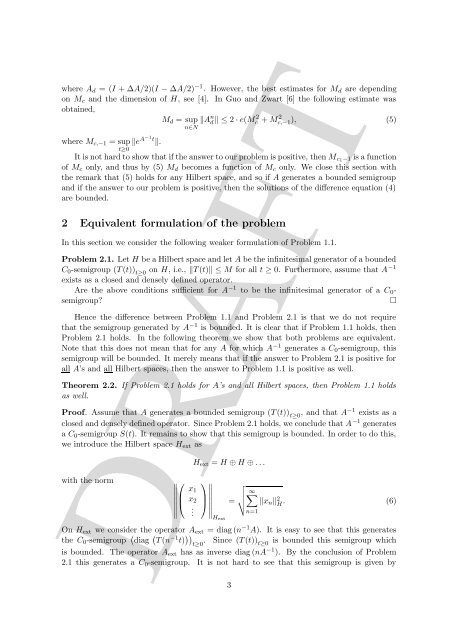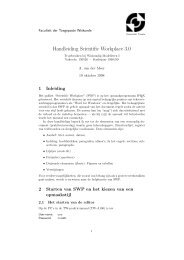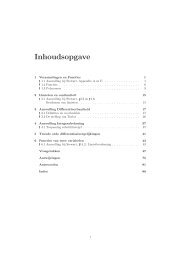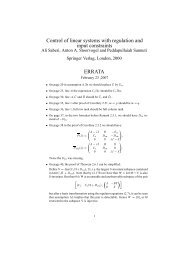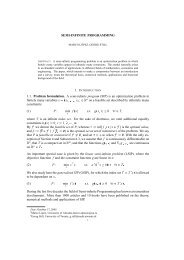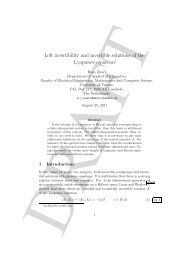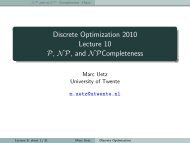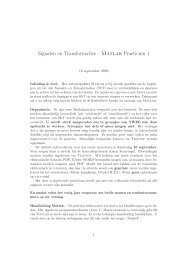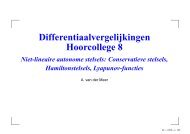Is Aâ1 an infinitesimal generator?â - Applied Mathematics
Is Aâ1 an infinitesimal generator?â - Applied Mathematics
Is Aâ1 an infinitesimal generator?â - Applied Mathematics
You also want an ePaper? Increase the reach of your titles
YUMPU automatically turns print PDFs into web optimized ePapers that Google loves.
where A d = (I + ∆A/2)(I − ∆A/2) −1 . However, the best estimates for M d are dependingon M c <strong>an</strong>d the dimension of H, see [4]. In Guo <strong>an</strong>d Zwart [6] the following estimate wasobtained,M d = sup ‖A n d ‖ ≤ 2 · e(M c 2 + M c,−1 2 ), (5)where M c,−1 = sup ‖e A−1t ‖.t≥0n∈NIt is not hard to show that if the <strong>an</strong>swer to our problem is positive, then M c1 −1 is a functionof M c only, <strong>an</strong>d thus by (5) M d becomes a function of M c only. We close this section withthe remark that (5) holds for <strong>an</strong>y Hilbert space, <strong>an</strong>d so if A generates a bounded semigroup<strong>an</strong>d if the <strong>an</strong>swer to our problem is positive, then the solutions of the difference equation (4)are bounded.2 Equivalent formulation of the problemIn this section we consider the following weaker formulation of Problem 1.1.Problem 2.1. Let H be a Hilbert space <strong>an</strong>d let A be the <strong>infinitesimal</strong> <strong>generator</strong> of a boundedC 0 -semigroup (T (t)) t≥0on H, i.e., ‖T (t)‖ ≤ M for all t ≥ 0. Furthermore, assume that A −1exists as a closed <strong>an</strong>d densely defined operator.Are the above conditions sufficient for A −1 to be the <strong>infinitesimal</strong> <strong>generator</strong> of a C 0 -semigroup?□Hence the difference between Problem 1.1 <strong>an</strong>d Problem 2.1 is that we do not requirethat the semigroup generated by A −1 is bounded. It is clear that if Problem 1.1 holds, thenProblem 2.1 holds. In the following theorem we show that both problems are equivalent.Note that this does not me<strong>an</strong> that for <strong>an</strong>y A for which A −1 generates a C 0 -semigroup, thissemigroup will be bounded. It merely me<strong>an</strong>s that if the <strong>an</strong>swer to Problem 2.1 is positive forall A’s <strong>an</strong>d all Hilbert spaces, then the <strong>an</strong>swer to Problem 1.1 is positive as well.Theorem 2.2. If Problem 2.1 holds for A’s <strong>an</strong>d all Hilbert spaces, then Problem 1.1 holdsas well.Proof. Assume that A generates a bounded semigroup (T (t)) t≥0, <strong>an</strong>d that A −1 exists as aclosed <strong>an</strong>d densely defined operator. Since Problem 2.1 holds, we conclude that A −1 generatesa C 0 -semigroup S(t). It remains to show that this semigroup is bounded. In order to do this,we introduce the Hilbert space H ext aswith the norm∥ ∥∥∥∥∥∥⎛⎜⎝x 1x 2.H ext = H ⊕ H ⊕ . . .⎞⎟∑⎠= √ ∞ ‖x n ‖ 2 H . (6)∥ n=1HextDRAFTOn H ext we consider the operator A ext = diag (n −1 A). It is easy to see that this generatesthe C 0 -semigroup ( diag ( T (n −1 t) )) t≥0 . Since (T (t)) t≥0is bounded this semigroup whichis bounded. The operator A ext has as inverse diag (nA −1 ). By the conclusion of Problem2.1 this generates a C 0 -semigroup. It is not hard to see that this semigroup is given by3


